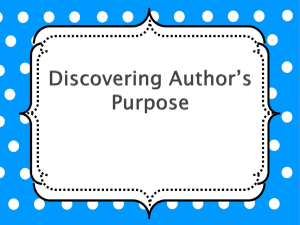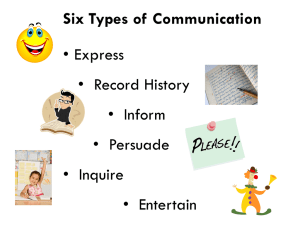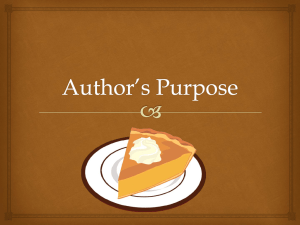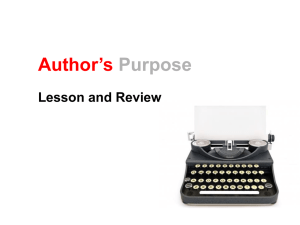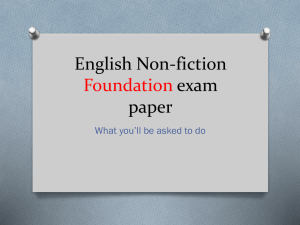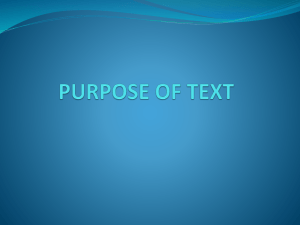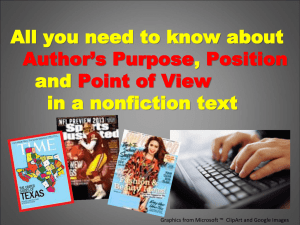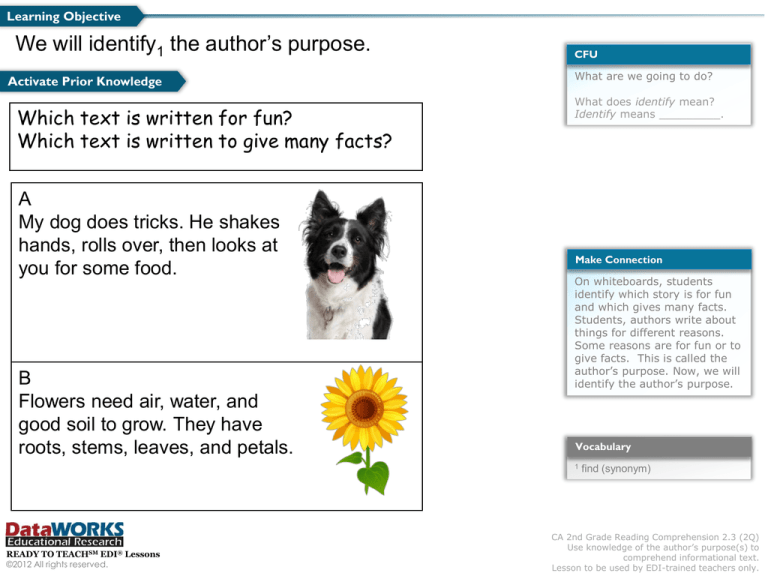
Learning Objective
We will identify1 the author’s purpose.
Activate Prior Knowledge
Which text is written for fun?
Which text is written to give many facts?
A
My dog does tricks. He shakes
hands, rolls over, then looks at
you for some food.
B
Flowers need air, water, and
good soil to grow. They have
roots, stems, leaves, and petals.
CFU
What are we going to do?
What does identify mean?
Identify means _________.
Make Connection
On whiteboards, students
identify which story is for fun
and which gives many facts.
Students, authors write about
things for different reasons.
Some reasons are for fun or to
give facts. This is called the
author’s purpose. Now, we will
identify the author’s purpose.
Vocabulary
1
TEACHSM
EDI®
READY TO
©2012 All rights reserved.
Lessons
find (synonym)
CA 2nd Grade Reading Comprehension 2.3 (2Q)
Use knowledge of the author’s purpose(s) to
comprehend informational text.
Lesson to be used by EDI-trained teachers only.
Concept Development
An author’s purpose is the author’s main reason for writing.
Identify author’s purpose
Author’s
Purpose
Definition2
Example
to entertain
to tell you a
story you will
enjoy
The three pigs loved to sing. The big bad
wolf
didn’t know how to sing. It made him sad. So,
the three pigs taught the wolf to sing.
to inform
to persuade
to teach or give
facts about a
topic
to get you to
believe
something
George Washington was born in 1732. He
was the first president of the United States.
He died in 1799.
Go to
Skill Dev 1
Dogs are the best pets. They are very loving
and helpful. It is fun to teach them new tricks.
You should get a dog.
Go to
Skill Dev 2
CFU 1
Which of these pieces of writing
is to entertain? Which is to
inform? How do you know?
A At my last birthday party, we
had a piñata. We all tried to hit
it. I broke it open. All my
friends jumped to get the
candy.
B Water freezes at 32 degrees.
Water boils at 212 degrees.
The human body is healthy at
98.6 degrees.
CFU 2
What is the difference between
writing to inform and writing to
persuade?
The difference between writing
to inform and writing to
persuade is ______________.
Which is an example of writing
to persuade? How do you
know?
A My brother, who is 2, had his
first pizza. He stuck his fingers
in and got red sauce all over
him.
B Pizza is a great food. It tastes
good and has many toppings.
You should have pizza every
day.
Vocabulary
2
©2012 All rights reserved.
meaning (synonym)
CA 2nd Grade Reading Comprehension 2.3 (2Q)
Author’s purpose.
Lesson to be used by EDI-trained teachers only.
Skill Development/Guided Practice 1
An author’s purpose is the author’s main reason for writing.
Identify author’s purpose.
1 Read the passage, thinking about the author’s purpose.
a Determine3 if the author is telling a story for the reader to enjoy.
b Determine if the author is teaching or giving facts to the reader.
c Determine if the author is telling the reader to believe something.
2 Identify the author’s purpose: to inform, to entertain, or to persuade. (circle)
CFU
2 How did I/you identify the
author’s purpose?
Playing with Water
1. Kristy was trying to squirt4 Mark with the water hose.
2. Mark was hiding. 3. When the back door opened, Kristy
squirted water at it. 4. It was Mom, and she got wet!
30 words
4
shoot liquid at
to inform
to entertain
to persuade
My Dog Marley
1. My dog’s name is Marley. 2. He loves to swim in the lake5.
3. Last summer, he ran into me, and we both fell into the water!
4. I still laugh when I think of that day!
34 words
5
large area of water surrounded by land
to inform
to entertain
to persuade
Vocabulary
3
©2012 All rights reserved.
figure out
CA 2nd Grade Reading Comprehension 2.3 (2Q)
Author’s purpose.
Lesson to be used by EDI-trained teachers only.
Skill Development/Guided Practice 1 (continued)
An author’s purpose is the author’s main reason for writing.
Identify author’s purpose.
1 Read the passage, thinking about the author’s purpose.
a Determine if the author is telling a story for the reader to enjoy.
b Determine if the author is teaching or giving facts to the reader.
c Determine if the author is telling the reader to believe something.
2 Identify the author’s purpose: to inform, to entertain, or to persuade. (circle)
CFU
2 How did I/you identify the
author’s purpose?
Abraham Lincoln
1. Abraham Lincoln’s birthday is on February 12th.
2. He was the 16th president of the United States.
3. He is remembered for freeing slaves6.
6
people who are not free
to inform
22 words
to entertain
to persuade
Poetry
1. Poetry has many words that rhyme. 2. Rhyming is when two
or more words sound the same at the end. 3. Rhyming words do
not have to be spelled the same way. 4. The words plane and
train rhyme.
36 words
to inform
©2012 All rights reserved.
to entertain
to persuade
Back
to Concept Dev
CA 2nd Grade Reading Comprehension 2.3 (2Q)
Author’s purpose.
Lesson to be used by EDI-trained teachers only.
Skill Development/Guided Practice 2
An author’s purpose is the author’s main reason for writing.
Identify author’s purpose.
1 Read the passage, thinking about the author’s purpose.
a Determine if the author is telling a story for the reader to enjoy.
b Determine if the author is teaching or giving facts to the reader.
c Determine if the author is telling the reader to believe something.
2 Identify the author’s purpose: to inform, to entertain, or to persuade. (circle)
CFU
2 How did I/you identify the
author’s purpose?
The Best Birthday Gift
1. This year for my birthday, I got a Gameboy7. 2. It is so small it
fits in your pocket. 3. It plays all kinds of games. 4. You should get one,
too! 5. It is the best video game player!
7
small video game player
to inform
41 words
to entertain
to persuade
Halloween
1. Halloween is the best holiday! 2. You get to
dress-up and pretend8 to be someone else. 3. The
best part about Halloween is you get to go
trick-or-treating9 to get lots of candy.
8
act like someone or something to have fun
to inform
©2012 All rights reserved.
9
(trick-or-treating) go house to house to get candy
to entertain
31 words
to persuade
CA 2nd Grade Reading Comprehension 2.3 (2Q)
Author’s purpose.
Lesson to be used by EDI-trained teachers only.
Relevance
An author’s purpose is the author’s main reason for writing.
1 Identifying the author’s purpose will help you
understand why the author wrote the book.
To Entertain
with a story about
Lulu the chick
To Inform
about 2nd Grade
school work
To Persuade
that twins are
not the same
2 Identifying the author’s purpose will help you do well
on tests.
Sample Test Question:
35. The author wrote this passage to
A give facts about different kinds of
cats.
B explain why cats do not like long trips.
C find a friendly family for a cat.
D tell about the life of one cat.
©2012 All rights reserved.
CFU
Does anyone else have a
reason why it is relevant to
identify the author’s purpose?
(Pair-Share) Why is it relevant
to identify the author’s
purpose? You may give me
one of my reasons or one of
your own. Which reason means
the more to you? Why?
CA 2nd Grade Reading Comprehension 2.3 (2Q)
Author’s purpose.
Lesson to be used by EDI-trained teachers only.
An author’s purpose is the author’s main reason for writing.
Skill Closure
Identify author’s purpose.
1 Read the passage, thinking about the author’s purpose.
a Determine if the author is telling a story for the reader to enjoy.
b Determine if the author is teaching or giving facts to the reader.
c Determine if the author is telling the reader to believe something.
2 Identify the author’s purpose: to inform, to entertain, or to persuade. (circle)
Ruth Wakefield
1. Ruth Wakefield made the first chocolate chip cookies in
1930.2. Her new cookie was called the "Toll House Cookie."
3. The first cookies she made used small pieces of chocolate.
to inform
29 words
to entertain
to persuade
Constructed Response Closure
Elise says the author’s purpose in this writing is to entertain. Why is she not correct?
Bicycles have two handlebars, two pedals, and two wheels. To ride a bike, you have
to steer and pedal while moving forward.
Summary Closure
What did you learn today about identifying the author’s purpose? (Pair-Share)
©2012 All rights reserved.
CA 2nd Grade Reading Comprehension 2.3 (2Q)
Author’s purpose.
Lesson to be used by EDI-trained teachers only.
Independent Practice
An author’s purpose is the author’s main reason for writing.
Identify author’s purpose.
1 Read the passage, thinking about the author’s purpose.
a Determine if the author is telling a story for the reader to enjoy.
b Determine if the author is teaching or giving facts to the reader.
c Determine if the author is telling the reader to believe something.
2 Identify the author’s purpose: to inform, to entertain, or to persuade. (circle)
Sharks
1. Sharks have up to 3,000 teeth. 2. Their teeth are arranged1 in
rows. 3. When one tooth is broken off, it is replaced by the tooth
1 lined up
behind it.
26 words
to inform
to entertain
to persuade
Playing Sports
1. Every child should play a sport on a team. 2. Being on a team
helps you to learn to get along with others. 3. This is why I believe that
every child should be on a sports team.
36 words
to inform
to entertain
Goldilocks and the Bears
1. Goldilocks went into the house of the three bears. 2. She
tried out all the chairs and the beds. 3. When the bears came
back, they found her sleeping in a bed.
to inform
©2012 All rights reserved.
to entertain
to persuade
30 words
to persuade
CA 2nd Grade Reading Comprehension 2.3 (2Q)
Author’s purpose.
Lesson to be used by EDI-trained teachers only.

